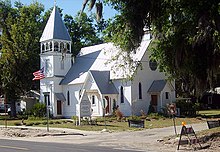
Back Carpenter Gothic Afrikaans Carpenter Gothic Danish Gótico carpintero Spanish Carpenter Gothic Estonian Gothique charpentier (architecture) French Ácsgótika Hungarian Carpenter Gothic Italian Плотницкая готика Russian






Carpenter Gothic, also sometimes called Carpenter's Gothic or Rural Gothic, is a North American architectural style-designation for an application of Gothic Revival architectural detailing and picturesque massing applied to wooden structures built by house-carpenters. The abundance of North American timber and the carpenter-built vernacular architectures based upon it made a picturesque improvisation upon Gothic a natural evolution. Carpenter Gothic improvises upon features that were carved in stone in authentic Gothic architecture, whether original or in more scholarly revival styles; however, in the absence of the restraining influence of genuine Gothic structures,[1] the style was freed to improvise and emphasize charm and quaintness rather than fidelity to received models. The genre received its impetus from the publication by Alexander Jackson Davis of Rural Residences and from detailed plans and elevations in publications by Andrew Jackson Downing.
- ^ The British denigration of Sir George Gilbert Scott's restorations at Ely Cathedral as "Carpenter's Gothic" are discussed in Phillip Lindley, "'Carpenter's Gothic' and Gothic Carpentry: Contrasting Attitudes to the Restoration of the Octagon and Removals of the Choir at Ely Cathedral". Architectural History 30 (1987:83–112).
© MMXXIII Rich X Search. We shall prevail. All rights reserved. Rich X Search